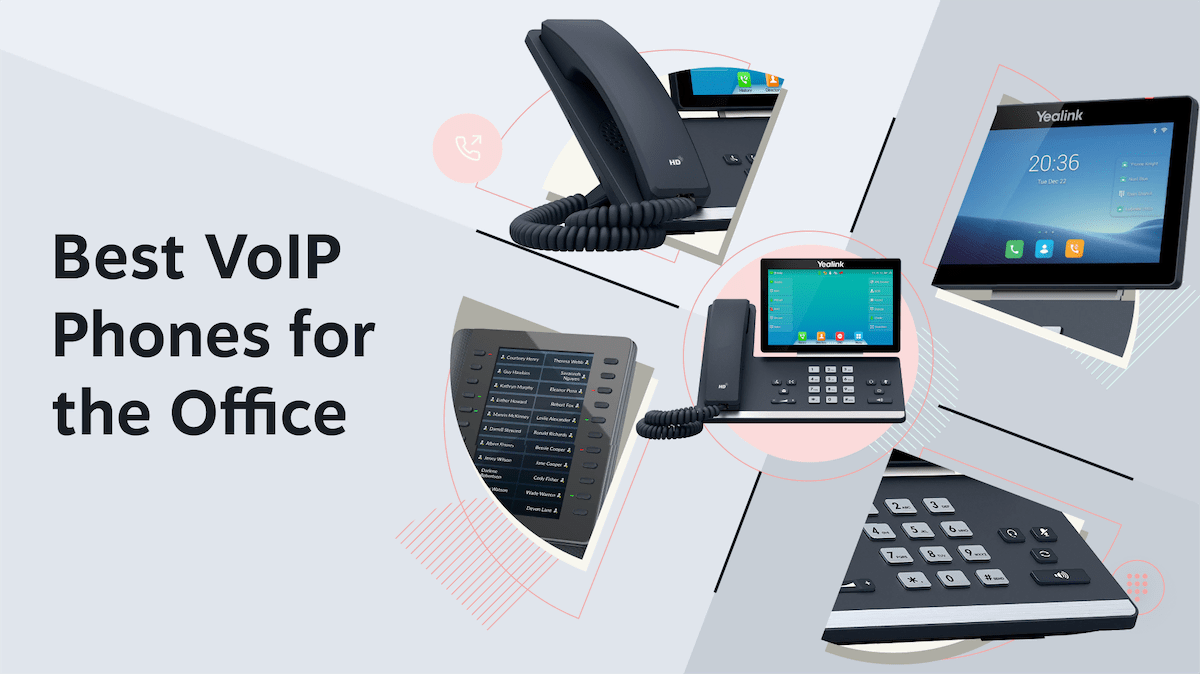Choosing the best office phones for your team directly impacts how customers experience your business. Static-filled calls, dropped lines, and outdated features frustrate callers and slow your staff down.
This guide breaks down the top Voice over Internet Protocol (VoIP) office phones for 2026, with clear comparisons of features, pricing, and use cases. By the end, you’ll know exactly which phones fit your small or midsize business — and how to upgrade from old landlines without wasting budget.
Why Choose VoIP Office Phones over Traditional Landlines?
Switching to a VoIP phone system offers many advantages over traditional landline phones, including:
- Cost savings: VoIP typically offers lower monthly costs and eliminates the need for expensive hardware and maintenance associated with traditional phone systems.
- Flexibility and scalability: VoIP phone systems are easily scalable, allowing you to add or remove lines as your business grows. They also offer greater flexibility for remote work and multi-location businesses.
- Improved mobility: Enable your employees to work from anywhere with a stable internet connection, maintaining seamless communication regardless of location.
- Advanced features: VoIP phone systems offer a wide range of advanced features such as call forwarding, call recording, voicemail-to-email, auto-attendant, and integration with CRM systems, often unavailable or costly with landline phones.
- Improved call quality: VoIP uses broadband internet connections, resulting in clearer call quality compared to traditional phone lines.
- Enhanced customer experience: Improve customer satisfaction with features like interactive voice response (IVR) systems, call queues, and music on hold.
- Environmental friendliness: Reduce your carbon footprint with VoIP’s lower energy consumption compared to traditional phone lines.

Top VoIP Office Phones for 2026: A Detailed Comparison
Here’s a breakdown of some of the best VoIP office phones on the market, categorized by user needs:
| Feature | Nextiva X-885 | Poly Edge E550 | Yealink T57W | Yealink T46U | Nextiva X-835 | Poly Edge E220 |
|---|---|---|---|---|---|---|
| Price annually/mo (approx.) | $190/$8.40 | $300/$8.80 | $310/$12 | $200/$7.60 | $120/$3 | $160/$2.75 |
| Screen size | 4.3″ Color | 5″ Color | 7″ Touchscreen | 4.3″ Color | 2.8″ Color | 2.8″ Color |
| Line keys | 12 | 12/48 (pages) | 11/29 (More) | 10 | 12 | 4/16 (pages) |
| Wi-Fi | Yes (Dongle) | Yes | Yes | Yes (Dongle) | Yes (Dongle) | No |
| Bluetooth | Yes | Yes | Yes | Yes (Dongle) | No | Yes |
| Headset ports | RJ9, USB, BT | RJ9, USB-C, BT | RJ9, USB, BT | RJ9, EHS | RJ9 | RJ9, USB-C, BT |
| PoE | Yes | Yes | Yes | Yes | Yes | Yes |
| Best for | Executives, Receptionists | Hybrid Workers | Executives, Heavy Callers | High Call Volume | Customer Support | Budget-Conscious |
1. Nextiva X-885
Ideal for: businesses prioritizing executive-level communication and streamlined workflows.
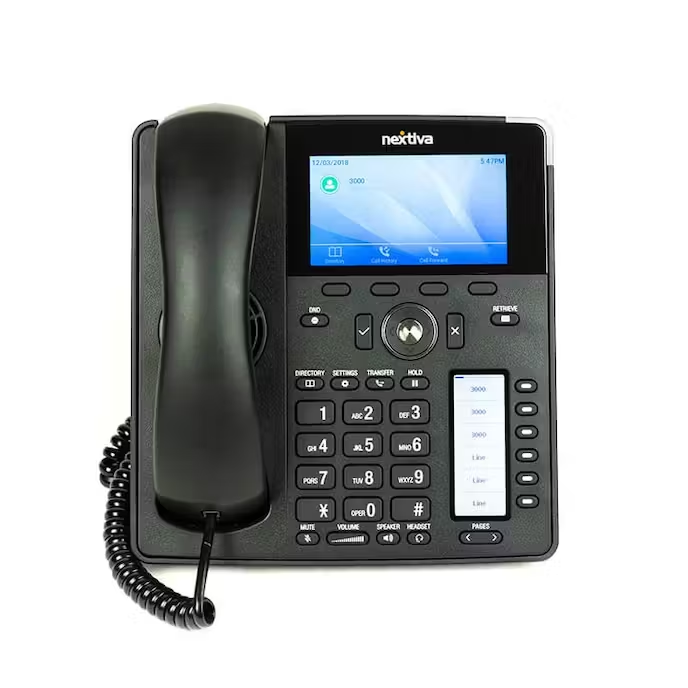
The Nextiva X-885 is designed for high-level communication needs, offering a premium experience for executives and front-desk personnel. Its 4.3-inch color display provides clear visibility, while the 12 programmable line keys offer quick access to frequently used contacts and features.
Built-in Bluetooth allows for seamless headset integration, and the inclusion of a Wi-Fi USB dongle adds wireless flexibility. The X-885 also boasts exceptional HD voice quality, ensuring crystal-clear conversations.
Price: $190.00 or $8.40/month
2. Poly Edge E550
Ideal for: hybrid teams that require seamless communication across different work locations.
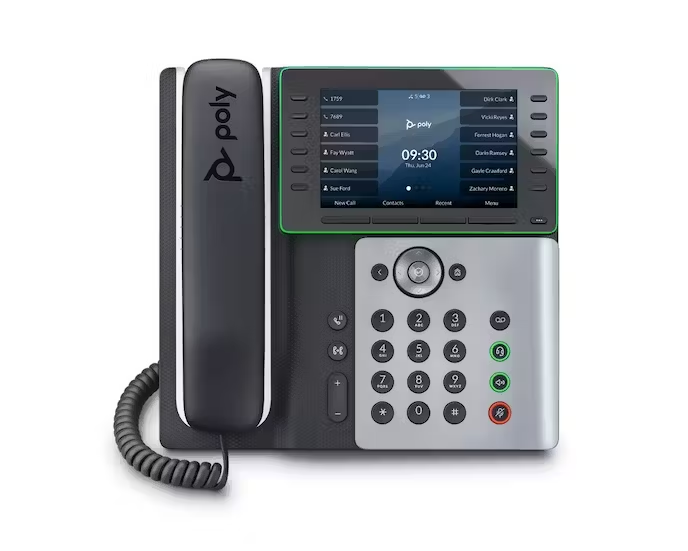
The Poly Edge E550 is tailored for the modern hybrid workforce, emphasizing flexibility and seamless connectivity. Its 5-inch color display offers a user-friendly interface, and the impressive 48-line capacity (across four pages) caters to users who manage multiple calls simultaneously.
Native Wi-Fi and Bluetooth enable wireless freedom, while USB-C and RJ9 ports ensure compatibility with various headset types. A standout feature is the fast pairing with compatible Poly headsets, simplifying setup and enhancing productivity.
Price: $300.00 or $8.80 per month
3. Yealink T57W
Ideal for: professionals who demand a high level of control and customization.
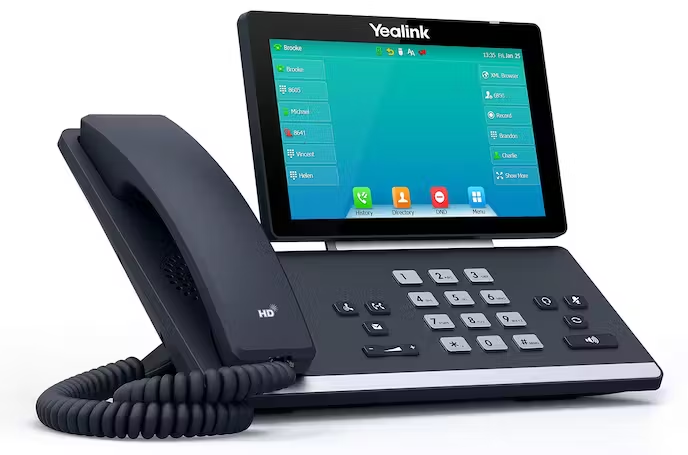
The Yealink T57W is a powerful IP phone designed for professionals who handle a high volume of calls. Its large 7-inch color touchscreen provides a user-friendly interface and simplifies navigation.
While it initially displays 11 line keys, the “More” key expands this to 29, and the option to add up to three EXP50 expansion modules allows for extensive customization. Built-in Wi-Fi and Bluetooth offer wireless connectivity, and the option to connect up to four DECT cordless handsets via a separate adapter adds further flexibility.
Price: $310.00 or $12.00 per month
4. Yealink T46U
Ideal for: businesses that prioritize crystal-clear audio quality and robust security.
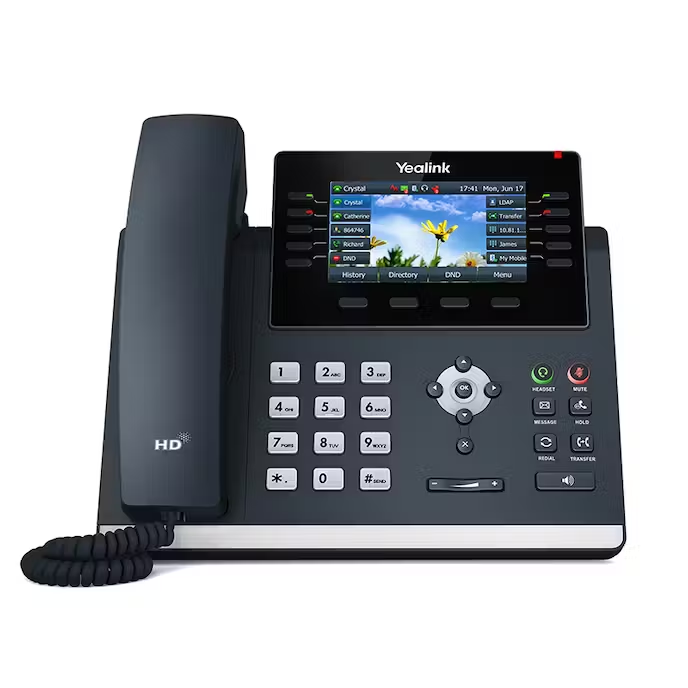
The Yealink T46U is a well-rounded mid-range IP phone that delivers excellent value and performance. Its 4.3-inch color display provides clear visibility, and the 10-line keys offer customization for individual needs. While it doesn’t have built-in Wi-Fi or Bluetooth, these can be added via USB dongles.
The T46U excels in audio quality, thanks to Yealink Optima HD Voice technology, ensuring crystal-clear conversations. Its robust security features, including HTTPS, SRTP, and TLS encryption, provide peace of mind for sensitive communications.
Price: $200.00 or $7.60 per month
5. Nextiva X-835
Ideal for: customer support teams and businesses seeking a balance of features and affordability.
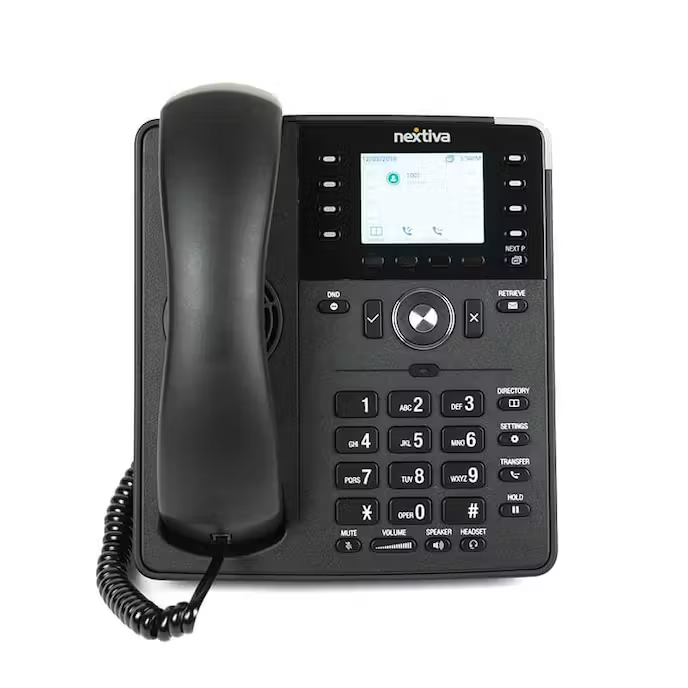
The Nextiva X-835 is a cost-effective IP phone that provides essential features for efficient communication. Its 2.8-inch color LCD screen provides clear information, and the 12 programmable keys offer quick access to frequently used functions.
While it requires a USB dongle for Wi-Fi connectivity and lacks native Bluetooth, it offers reliable performance and essential features like speed dialing and an RJ9 headset port.
Price: $120.00 or $3.00 per month
6. Poly Edge E220
Ideal for: small businesses seeking a balance of affordability and essential features.
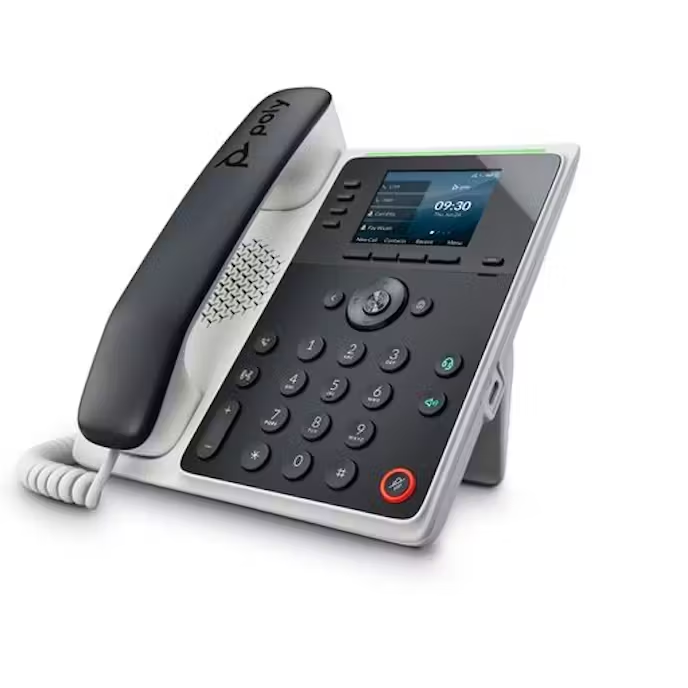
The Poly Edge E220 is a budget-friendly IP phone that packs surprising features into a compact design. Its 2.8-inch color screen provides basic information, and while it has only four physical line keys, it supports up to 16 lines across four pages.
Built-in Bluetooth and NFC offer wireless convenience, and the inclusion of USB-C and RJ9 ports ensures compatibility with various headsets. The E220 also features text-to-speech, making it more accessible for users with visual impairments.
Price: $160.00 or $2.75 per month
Benefits of VoIP Desk Phones
A VoIP desk phone offers many advantages that softphones alone can’t fully replicate. Here’s why you should consider upgrading from a traditional landline to a VoIP desk phone:
- Dedicated, reliable calling experience: VoIP provides stable connectivity over the internet, minimizing call disruptions and downtime.
- Built-in integrations with softphones: Softphones like Nextiva, Microsoft Teams, Google Meet, and Zoom Phone extend communication to any internet-enabled device, enhancing mobility and collaboration for remote and hybrid teams.
- Easy, instant calling & flexibility: VoIP services offer accessories like USB dongles and headsets for enhanced functionality.
- Better call quality, including speakerphone: VoIP supports HD audio and wideband codecs, delivering superior call clarity. Speakerphones with noise reduction and echo cancellation further enhance audio quality.
- Advanced features: VoIP provides features like call recording for training and compliance, voicemail-to-email for convenient message retrieval, call analytics for performance monitoring, and CRM integration for streamlined workflows.
- Enhanced security: VoIP systems use encryption protocols (HTTPS, SRTP, TLS) and network security measures to protect communication data.
Useful Office Phone Accessories
Your office phone isn’t complete without one or more of these VoIP phone accessories and hardware.
Headsets
VoIP headsets allow you to make and receive calls hands-free. Choose from mono (single ear – ideal for staying aware of your surroundings), stereo (dual ear – best for focused calls and immersive audio), and noise-canceling headsets (essential for noisy environments). Wired headsets provide reliable connectivity, while wireless headsets offer greater freedom of movement.
Prices of VoIP headsets vary greatly based on their features and complexity. They can start at $15 and go up to $500 or more.
Wireless dongles
A wireless dongle is a small hardware device that helps you connect your VoIP phone to a Wi-Fi network or Bluetooth device. You’ll need them if your office phone lacks native Bluetooth and wireless network connectivity.
The exact price depends on what you’re getting. The Nineplus wireless dongle for Wi-Fi costs about $30, while the Maxuni USB Bluetooth dongle costs about $18.
PoE equipment
Power over Ethernet (PoE) delivers both data connectivity and electrical power to your VoIP desk phone simultaneously through a single Ethernet cable. This simplifies installation and reduces cable clutter.
All Nextiva’s VoIP phones are PoE compatible, but this isn’t the case with all other VoIP service providers. Before investing in PoE equipment, check with your service provider to be sure your phone supports PoE.
Once confirmed, you can buy your PoE equipment via your service provider’s hardware and accessories store. You can also purchase this equipment on e-commerce marketplaces, such as Amazon. Some PoE devices cost as little as $16.
Pair Your Office Phone With the Right Business Phone Service: Nextiva
Investing in the best office phones is only half the equation. To get clear calls, reliable uptime, and all the features your team depends on, you also need a business phone service that can keep up. Nextiva brings your phones, numbers, and users together in one simple platform, backed by friendly support and flexible business phone plans for growing teams.
See how Nextiva’s business phone system can power your new office phones and help your team stay connected from anywhere.
Upgrade to the best business phone system
Nextiva is the best unified communications solution every small business needs with pricing every small business wants.
VoIP Office Phones FAQs
Get answers to common questions about VoIP office phones.
Office phones range from $100 to $300, depending on features. Leasing options and monthly subscriptions are also available, allowing you to spread the cost over time. Consider the total cost of ownership, including potential savings on long-distance calls and advanced features compared to traditional phone systems.
For example, Simple VoIP phones, such as Nextiva’s X-885, cost as little as $8.40 per month, while a phone like the Yealink T57W costs about $12 per month. Be sure to get a price quote and see your options.
The Nextiva X-835 and Poly Edge E220 offer a great balance of features and affordability for small businesses.
For enterprises, consider phones like the Cisco 8861 and Yealink T57W, which offer advanced features, scalability, and integration with enterprise-level systems.
Most VoIP phones are easy to set up. Typically, you connect the phone to your network via Ethernet or Wi-Fi and then configure the settings using a web interface or the phone’s display. Consult your VoIP provider’s setup guide for specific instructions. Read our helpful guide for setting up a VoIP phone.

















 VoIP
VoIP 

